Why you can trust TechRadar
We spend hours testing every product or service we review, so you can be sure you’re buying the best. Find out more about how we test.
MagStor Thunderbolt 3 LTO Drive: 30-second review
In my early career at Future, tape storage was commonplace and used for storing old publications, website iterations, and, of course, covermount CDs and DVDs. These days, there’s little need for those smaller tape drives, as a simple flash drive offers storage that far exceeds what they had to offer. However, in my post-Future career, tape drives always seem to be somewhere in the background, hidden away in an IT cupboard, acting as incremental backup of servers in case of a hack or meltdown.
Tape has always been a great choice for archiving and is used by many museums and service industries because the tapes themselves, which are essentially replaceable cassettes, can be stored for decades making it a far more robust solution than HDDs, which are more likely to fail, or SSD, which is just phenomenally expensive for the data equivalent cost.
The MagStor Thunderbolt 3 LTO (Linear Tape-Open) tape drive is an interesting combination of this almost legacy format and the latest technology. First of all, you have the Thunderbolt 3 interface, which has the potential to offer up to 40 Gb/s data transfer speed, which, for a tape format that can only offer up to 400 MB/s, will initially seem a bit odd. However, that Thunderbolt 3 connection will offer a future-proof interface.
The two technologies, tape and Thunderbolt, play off against each other exceptionally well, and through the test, I was impressed with the transfer speeds that were achievable using this combination of the technologies. Keep in mind that the LTO tape drive is used as archival and storage media rather than anything that you would use as a working drive.
In this test, I used the LTO cassette to back up several 5 TB HDDs that stored video projects shot on a variety of Canon and Sony camcorders and mirrorless cameras over the years, and edited in a variety of applications from Final Cut Pro X to Adobe Premiere Pro and DaVinci Resolve. All projects from those applications, along with all the media, had already been archived, so they were ready to be copied across to the tape, then popped on the shelf so that they could be recalled as and when needed.
The process of copying over to the LTO tape drive is slightly different to a standard drive, as you do need software in order to access the contents, and MagStor utilises the Hedge Canister LTFS software, with a perpetual licence included with the purchase of the drive. You also get a year’s worth of updates, after which, if you want to keep up to date with any developments for the software, there is a yearly charge; at present, this is $399 for the year.
The Hedge Canister, LTFS software is one of the easiest pieces of tape drive software that I’ve ever come across. Once installed and loaded, the drive just appears as with many other drives, and you can simply drag your content onto the Hedge Canister interface window to archive it to the drive. Then, when you want to recall any data that’s stored on the drive, you can simply browse the folders through the software and copy that folder back onto a local working drive.
Whilst you can access the drive directly through the usual OS navigation in either macOS or Windows 11, due to the technology behind tape with the right software installed, it’s better to use this dedicated software as it puts less strain on the tape.
In use transfer rates are fast, but nowhere close to the Thunderbolt 3 speeds, however, considering that this is a tape drive, I managed a maximum of 349 MB per second with an average when I transferred a 1.65 TB project, of 246 MB per second, with the transfer taking 3 1/2 hours. This might seem like a relatively slow transfer compared with SSD, but for archival, this is exceptionally good and far faster than some of the tape systems that I’ve used in the past.
One other major advantage of using tape is its archival potential. A single cassette can sit on the shelf for many years, even decades, without degrading, meaning that, unlike an HDD or other storage medium, your backup of old projects is far more likely to survive the test of time. Unlike HDD, it doesn’t require being spun up every so often to keep the integrity of the drive.
At the end of the test, whilst I was impressed with the performance and I can definitely see the benefit of a tape system over any other type of mass storage, for me, this is a perfect option for backing up video project files and other data.
The initial cost of the drive is still prohibitive and whilst tape drives at present are relatively inexpensive for an LTO-9, the cost is steadily climbing; however, when you compare an 18 to 45 TB tape that’s going to set you back around £100 with the HDD equivalent, which will be closer to £600–£700, you very quickly see how one of these tape drives and tapes will quickly pay for itself within a production studio or any company that requires huge amounts of data storage.
MagStor Thunderbolt 3 LTO Drive Price & availability
- How much does it cost? $6500 / £6500
- When is it out? Now
- Where can you get it? Widely available
At around £6,500/$6500, the MagStor Thunderbolt 3 LTO tape drive is by no means cheap, especially once you add the cost of a 10-pack of LTO tape cartridges at another $1500 or £1500 and the yearly recycle of the Hedge Carnister LTFS software updates.
However, when you start to compare this quantity of on-site archival data storage against the alternatives, you can very quickly see that this is actually an extremely cheap option for anyone who needs huge data storage.
MagStor Thunderbolt 3 LTO Drive: Design
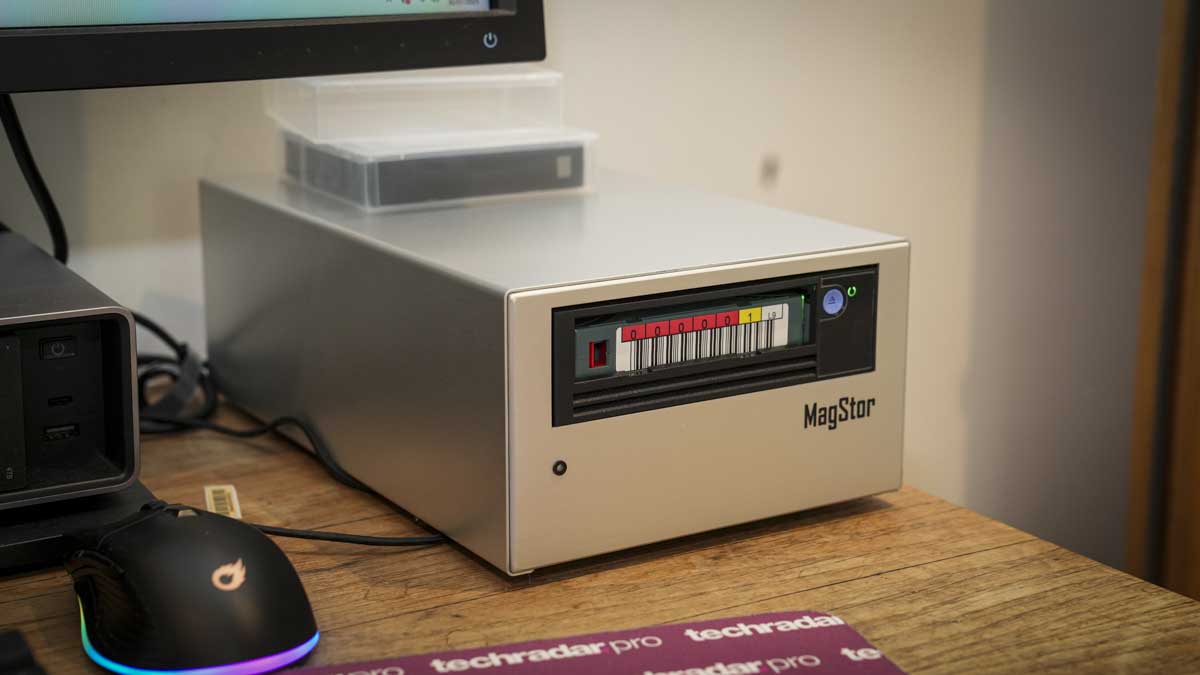
Specifications
Interface: Thunderbolt 3 (up to 40 Gbps bidirectional; 120 Gbps one‑way)
Tape Format: LTO‑9 supported
Native Speed: 400 MB/s (LTO‑9)
Compression: 2.5× (up to ~45 TB for LTO‑9)
OS Compatibility: macOS and Windows
Power Delivery: Internal PSU standard
Back in the late to mid-90s, I bought my first CD writer, and at the time, this cutting-edge technology cost me somewhere in the region of £10,000 and sat alongside a tape system I’d inherited, both in small metal rectangular boxes, that made a lot of noise.
That tape system was used to archive our video footage shot on D2 and MiniDV tapes, as it was the only system with enough data storage at the time to cope.
The design and build of the MagStor Thunderbolt 3 LTO tape drive hasn’t really moved on and is very reminiscent of these older external CD and tape drives that I used early in my career, and likewise, is capable of storing data in excess of any other type of storage media.
Today, whilst there are HDDs with 30+ terabyte data capacities, they come in at several hundred pounds per unit, and of course, are not transferable in the same way that the LTO-9 cassettes can be ejected and stored with relative ease and security.
The design of the drive is essentially a rectangular metal box with a power supply and an on switch at the back, a hole for the fan to keep the internal workings cool, two Thunderbolt 3 ports at the back so you can daisy chain additional drives or other Thunderbolt 3 devices, and then round the front, you have the eject button and the slot to insert the LTO-9 cassette.
When it comes to overall design, the drive is extremely simple with very little to it, and all interaction with the drive and the data that copies across to the cassettes is handled through the software required to fully utilise the functions and options that this drive has to offer.
Getting started is all easy enough: simply plug in the power, plug the Thunderbolt 4 cable supplied, from the device into your computer. Make sure that you have the Hedge Canister LTFS software installed, follow the instructions, download all of the drivers that you need and then locate the drive and cassette once it’s inserted.
From then on, it’s a case of just using the software to upload files or retrieve them, with features built in that enable you to create catalogues, adjust what files are and are not archived and queue up uploads ready to copy over to the tape.
Once you’ve finished copying everything across, then the cassette can be ejected, placed back in its case and stored on the shelf or in a controlled environment for many years to come.
MagStor Thunderbolt 3 LTO Drive: Features
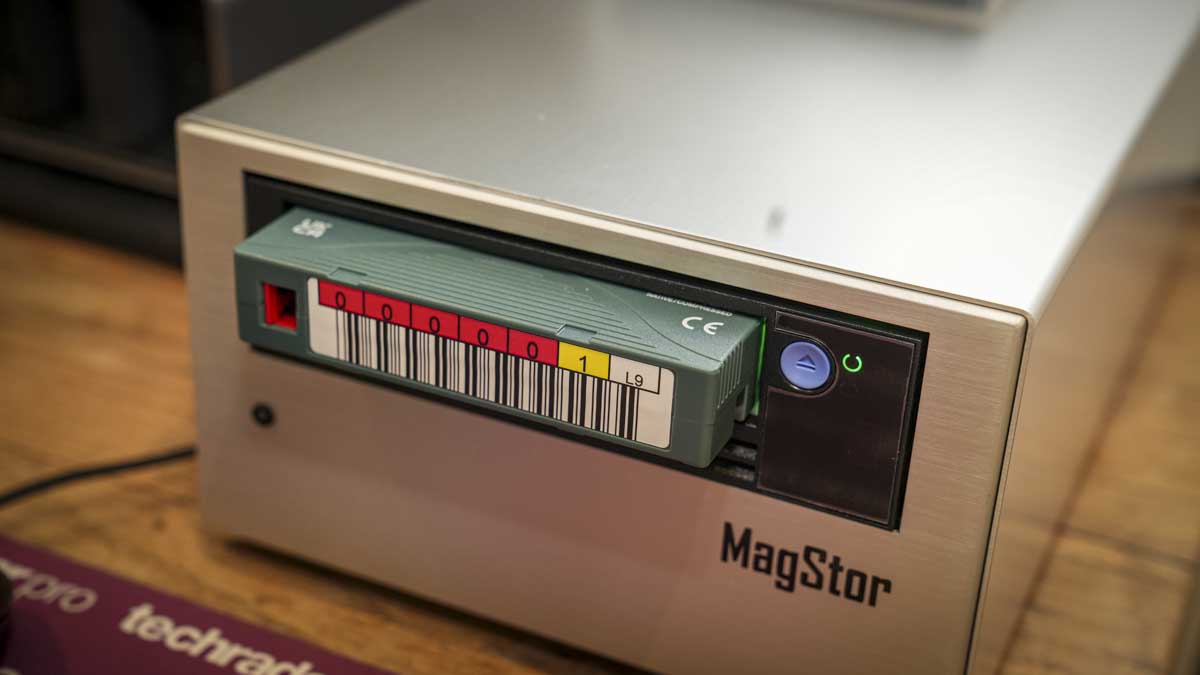
One of the big features of the LTO tape drive is that it offers a Thunderbolt 3 interface, and while the tape technology can’t actually match the speed that is on offer through that interface, it does mean you get better reliability and also ensures that the drive will be future-proof for many years to come. While the Thunderbolt 3 interface is now a few years old the transfer rates far exceed the requirements of the LTO tapes and has wide compatibility.
One advantage of the Thunderbolt 3 interface is that you can daisy chain up to three devices, so if you start off with a single tape drive and decide that you need another, then that secondary drive can be stacked on top of the first and daisy chained.
One of the surprises of this drive is just how simple MagStor have made it, so whilst other LTO drives require some technical knowledge, especially for network-connected drives, the focus here is to create a drive accessible and easy to use for anyone with or without an IT department.
The drive itself simply connects in through Thunderbolt 3, and as there is no network connection, there’s no network configuration to do, which instantly makes this easier to use than most other systems I’ve come across recently.
The one thing that is required is that you have some compatible software to complement it, and a perpetual licence of Hedge Canister LTFS software with a year of updates is included in the cost of the drive itself. After that, you will need to buy the continuous licence to keep receiving updates or just use it as is.
If you are archiving a lot of data, this software is essential, as if you just use your OS browser, it won’t have all the drive integrity checks and management that the software includes and would put additional strain on the tape itself.
When it comes to the storage media this is a tape cassette known as an LTO (Linear Tape-Open), and these offer a native 18 TB of storage however, with the software some files are compressed which means that you can store an equivalent of 45 TB of data, however, if your backing up video files that have already been compressed then you’re looking at something closer to 18 TB. The compression options can be switched on and off through the software, and do vary greatly depending on the file type being archieved. Archiving data is the big feature of these cassettes, and LTO tapes are essentially built to last for 30 years under normal environmental conditions, which is far in excess of almost any other type of media.
When it comes to speed of transfer, whilst the Thunderbolt 3 interface will offer 2 GB/s, here, with the constraints of the tape drive system, that is limited to about 400 MB per second, still incredibly fast for this type of technology.
The design does look like something from the late 90s or early 2000s, and whilst many companies have gone for ultra product design, here it’s just a very functional box, and because of the design and shape, it’s very easy to position alongside your workstation.
MagStor Thunderbolt 3 LTO Drive: Performance
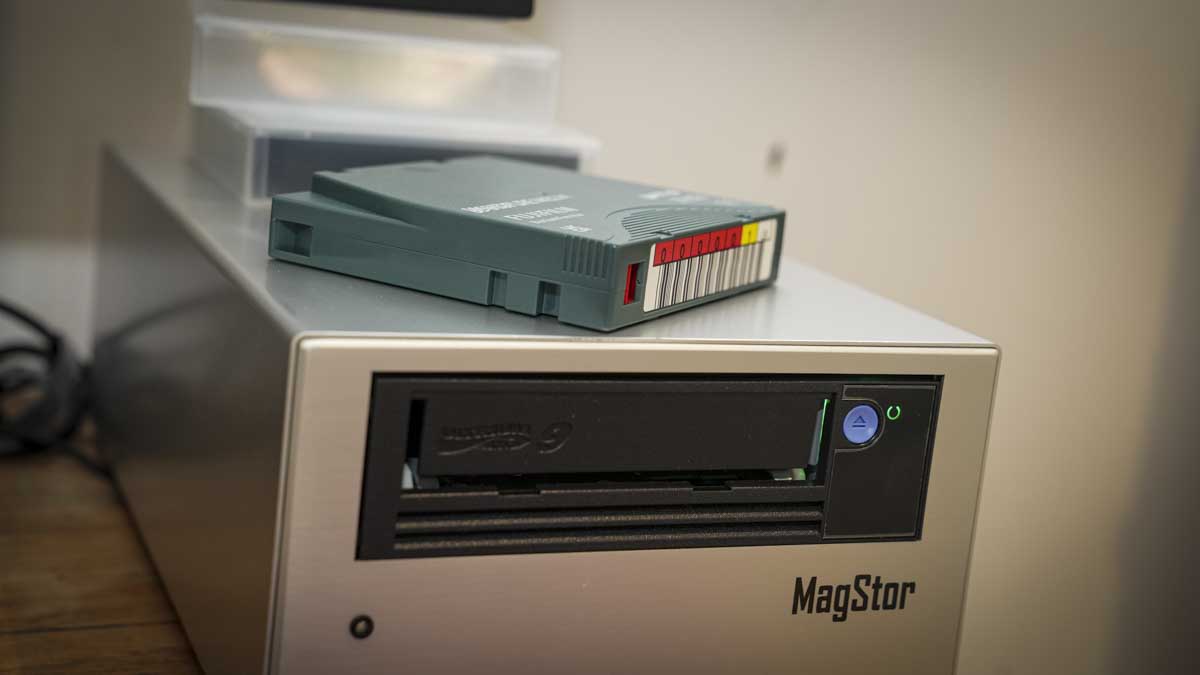
Benchmarks
CrystalDiskMark Read: 215.61MB/s
CrystalDiskMark Write: 309.98MB/s
ATTO Disk Benchmark Read: 59.53MB/s
ATTO Disk Benchmark Write: 349.89MB/s
Getting started with the MagStor Thunderbolt 3 drive is simple: plug in the Thunderbolt 3 cable and AC power, and switch on. Then go to your PC or Mac, download the Hedge Canister LTFS software and run through the setup process, which takes about five minutes, insert the cassette and wait for the software to first test the drive, then the cassette, and then you’re ready to get started with archiving all your data.
In this review, I’ve tested the drive on Thunderbolt 4 with a MacBook Pro M1 Max and an ASUS Prime Z890-P motherboard with USB4 and a ASUS ThunderboltEX 5 installed to test compatibility on a variety of interfaces.
In the first test, I used several 2 TB drives with raw footage that needed archiving. The first step is to drag the files over to the interface, then to create a catalogue to copy the files to and then start the process. If there are other files to transfer, then you can repeat the process, queuing the additional folders and files. Transfer rates between the tape drive and the SSD were exceptionally good, with 1.6 TB of data taking around 3 1/2 hours to copy the files across, through this time I saw an average of 246 MB per second, which, while not fast, is completely acceptable for a data storage device that will only be accessed once in a while.
Once the initial download had started, I went back to some of my older archive HDDs, each of which is a LaCie Rugged 5 TB. I use these as a secondary archival project store that is then backed up to my increasing stack of NAS drives; otherwise, they sit on a dusty shelf until they are required.
While many of these drives have sat there perfectly happily for several years, I do tend to do an integrity check at the start of every year, and inevitably, one or two of those drives will be a little bit sticky, and I will need to replace them in order to keep that data.
As I started to transfer these HDDs over to the tape system, the one thing that was apparent was that whilst the tape system is relatively slow at 200 to 400 MB/s average, my HDDs were considerably slower again and more like 50 MB/s. In the end, I just left the tapes running and managed to download 15 TB drives to a single tape, giving me a second backup of that valuable data.
The process was simple, if not quick and when complete, the cassette could be placed into the small case and stored away, knowing that it’s going to be good for at least 30 years.
One aspect of the software that stood out was the ease of use, with three distinct areas to the workflow: Archive, Retrieve and Transfer (Which just shows you the files transfer to or from the drive).
Whilst the actual use of the drive itself is extremely simple, the fact that it offers such huge amounts of data storage does give it an advantage over other systems, especially when it comes to the robustness and longevity of the storage medium compared with an HDD or SSD.
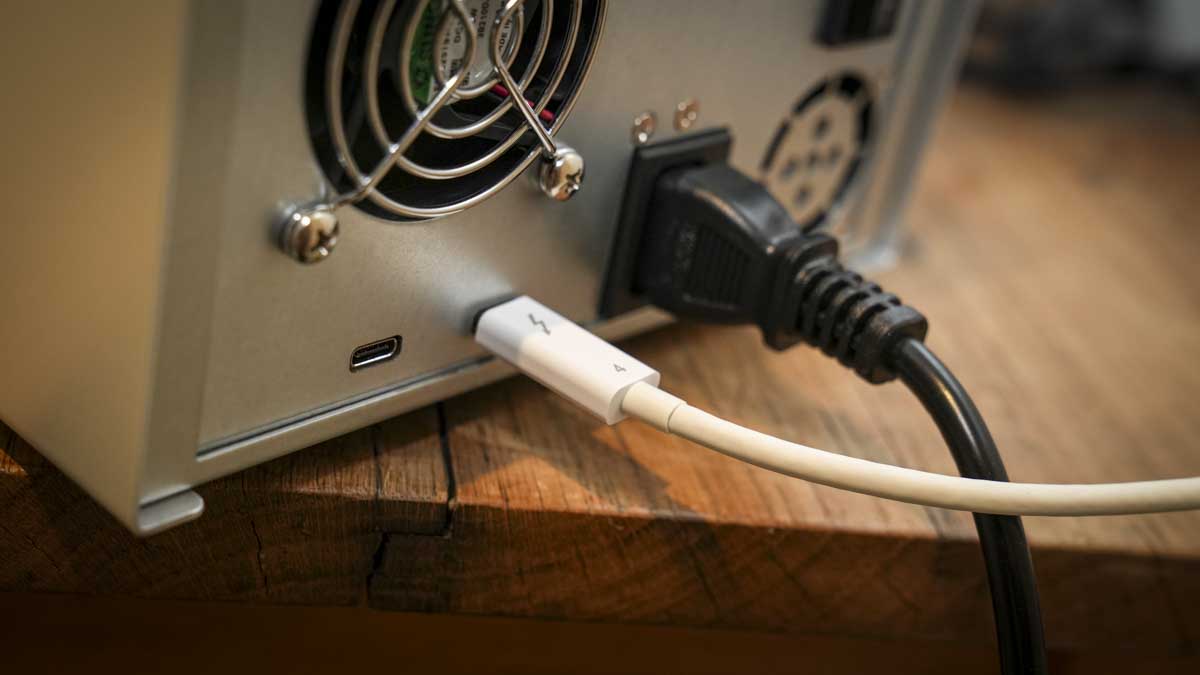
MagStor Thunderbolt 3 LTO Drive: Final verdict
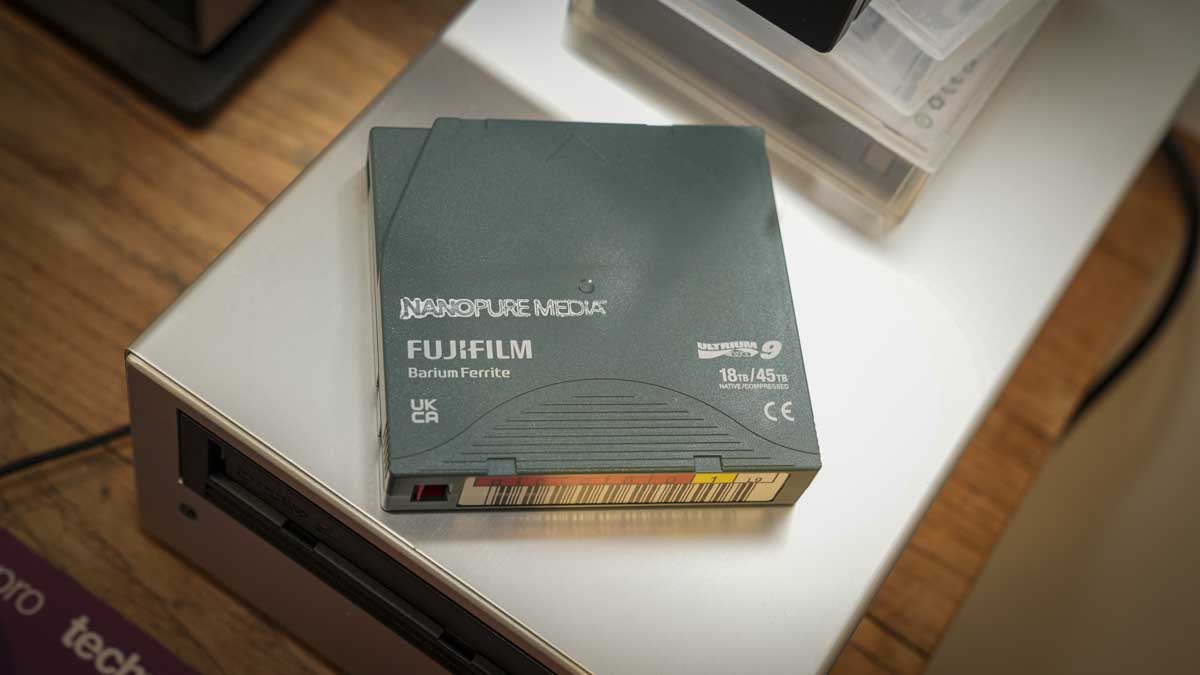
Initially, unless you’re an enterprise business, the advantage of having a tape drive system is quite a hard sell, as the initial outlay is expensive, especially considering that you can get an OWC 20 TB Jupiter Mini with 20 TB storage for under £3000 / $3000. However, with that solution, it’s designed as a working drive with the data always accessible, and those drives will always be spinning. While 18 TB doesn’t seem like a lot of data when it comes to video production, that data will be eaten up in no time.
Here, with the LTO-9 cassette offering 18 TB of data or 45 TB compressed where possible, I can store all of that data on one single cassette, then pop a new one in again to store another 18 to 45 TB of data, and with a LTO-9 tape costing $80/£80 at the time of review, the difference in cost between additional NAS Systems or a new cassettes shows why tape systems make economic sense.
As an example, your average disk-based storage will set you back $1.18 per TB, whereas you’ll be looking at something closer to $0.49 for the tape storage. You do obviously have the cost of the drive to consider, but when dealing with mass storage for video, the initial outlay for the drive will be absorbed by the cost saving on not only the tapes compared with the HDD but also the storage and maintenance.
While the transfer is fast, the fact that this is used as archival storage and not for working does make it acceptable, considering the benefits. The Thunderbolt 3 connection, while seeming a little bit overkill for technology, does ensure a good, robust connection and, more importantly, also offers a certain level of future proofing.
Then you also have the advantage that Thunderbolt 3 enables daisy chaining, so if you start off with one drive but then you need more drives to back up more data as your business or production studio grows, then you can. Up to three drives can easily be added and the configuration utilising the Hedge Canister LTFS software is just exceptionally easy and works both on Mac and PC systems.
MagStor’s inclusion of the Hedge Canister software is what really excites me about this as a storage solution, as it brings LTFS, a format required by Netflix, into a far more user-friendly environment with features like checksum verification and an easy-to-use drag-and-drop interface. So, no command line coding to ensure that everything is working and in place.
For any small to medium-sized production studios or companies that require data storage, the advantages of this tape system very quickly become apparent, and whilst it might not appeal to many smaller businesses, its cost per TB very quickly balances out compared with any other solution.
In addition to that, and more importantly, the archival potential is huge, so while today’s latest technology will enable you to store that data for years, tape is a tried and tested format and ideally suited to archiving data.
Should I buy the MagStor Thunderbolt 3 LTO Drive?
|
Value |
The initial outlay is huge, but when you swap cassettes for storage, that cost does balance in the long run |
4 |
|
Design |
The drive looks like a system from the late 90s or early 2000s and is distinctly professional rather than aesthetically designed |
4 |
|
Features |
The main feature of the machine comes through the way the Hedge Canister software accesses and manages the drive |
5 |
|
Performance |
While transfer speeds are relatively slow despite the Thunderbolt 3 interface, for this style of archive storage, the speeds are actually quite impressive |
5 |
|
Overall |
This is a piece of computer equipment designed with the sole purpose of archiving data, and for that task, it works exceptionally well |
4.5 |
Buy it if…
Don’t buy it if…
For more storage solutions, we’ve tested and reviewed the best external hard drives and the best portable SSDs.









